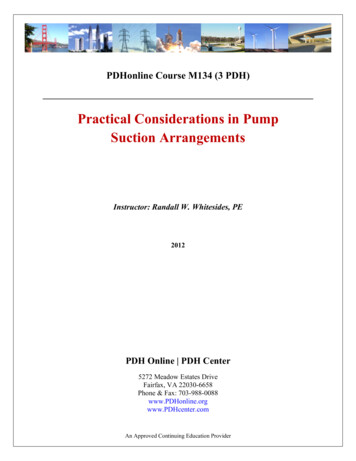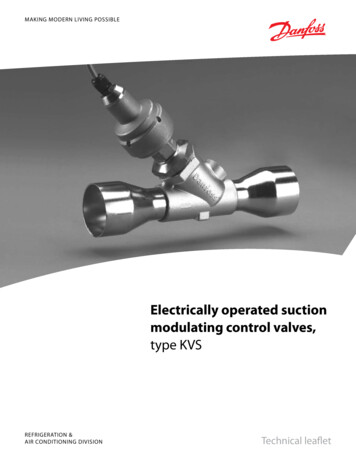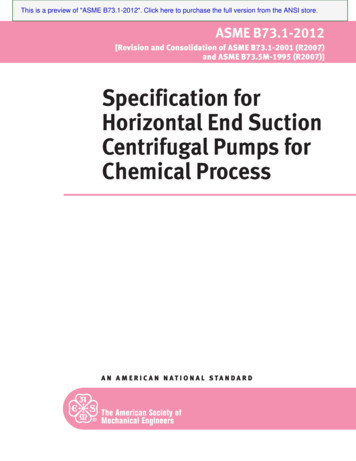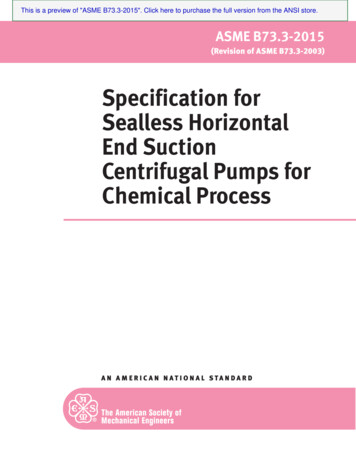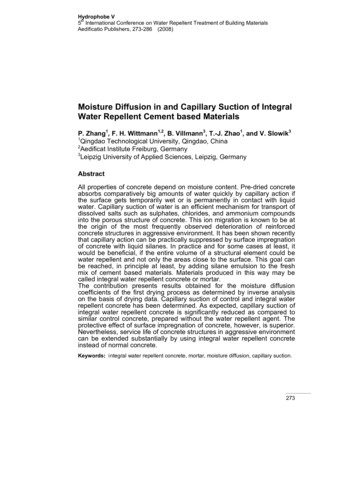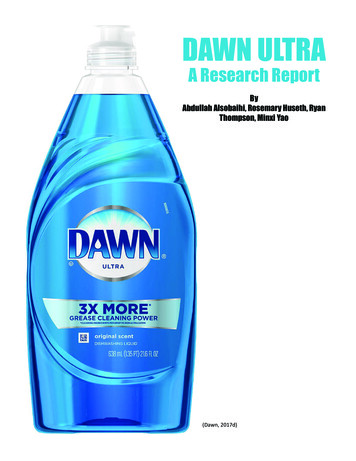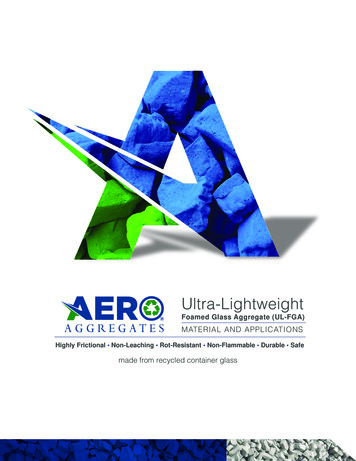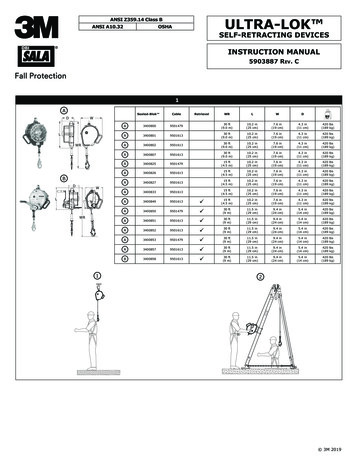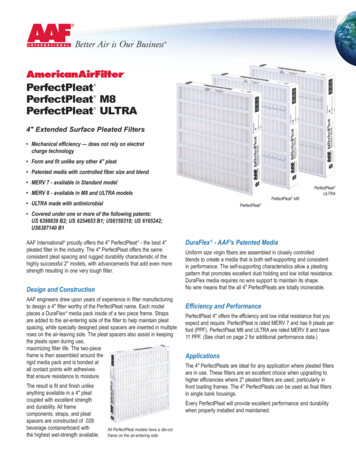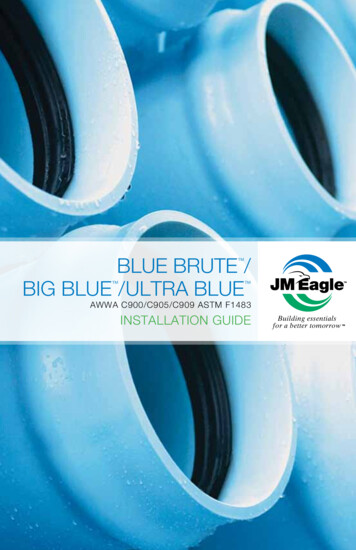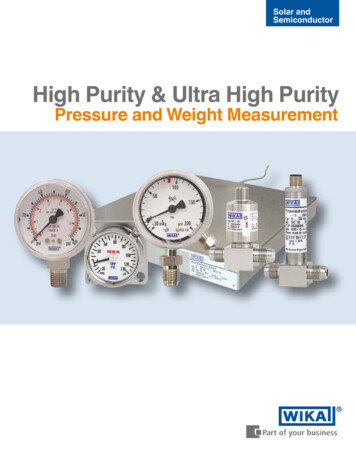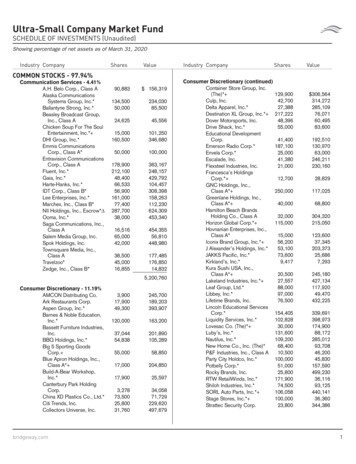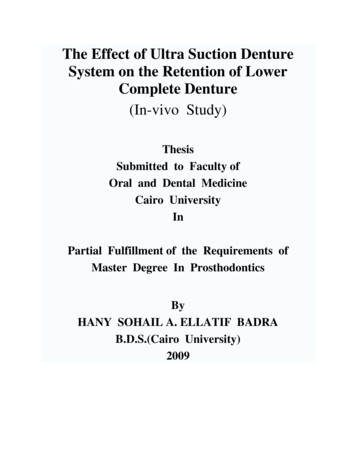
Transcription
The Effect of Ultra Suction DentureSystem on the Retention of LowerComplete Denture(In-vivo Study)ThesisSubmitted to Faculty ofOral and Dental MedicineCairo UniversityInPartial Fulfillment of the Requirements ofMaster Degree In ProsthodonticsByHANY SOHAIL A. ELLATIF BADRAB.D.S.(Cairo University)2009
SupervisorsProf. Dr. Alaa Abo-ElalaProfessor of prosthodonticsFaculty of Oral and Dental MedicineCairo UniversityAss. Prof. Dr. Eman Abd-ElwahabAssistant Professor of ProsthodonticsFaculty of Oral and Dental MedicineCairo University
AcknowledgmentFirst and foremost, I am greatly thankful and grateful to Allah for grantingme the chance to accomplish this work.I would like to express my most sincere gratitude and grateful appreciationto Dr. Alaa Abo-Elala Professor of Prosthodontics, Cairo University forher inspiration , encouragement and guidance which undoubtedly made thiswork possible.I am deeply grateful to Dr. Iman Abdel Wahab, Lecturer ofprosthodontics, Cairo University for her precious help , encouragement,guidance and valuable efford.I would like to thank my colleagues and all the stuff members of theprosthodontic department ,Faculty of oral and Dental Medicine, CairoUniversity, who continuously encouraged me throughout this study.Last but not least, I would like to thank my dear parents and my lovelywife for their support in the good as well as in the bad days.Hany Badra
ContentsTitlePageIntroduction1Review of literature2I.II.Definition2Factors Affecting Retention of Complete Denture21.Physical Factors3a) Adhesion3b) Cohesion4c) Surface tention4d) Surface area5e) Capillary attraction5f) Viscosity6g) Wettability6h) Atmospheric pressure6i) Border seal72.Physiological Factorsa) Saliva88
b) Neuromuscular control83.Anatomical Factors94.Mechanical Factors125.Surgical Factors14a) Vestibuloplasty14b) Ridge augmentation14c) Distraction osteogenesis156.Psychological Factors157.Clinical Implications178.Retentive Aids19a) Suction cups19b) Magnets20c) Soft liner21d) Adhesives22e) Implant retained overdenture23Ш Methods of measuring retention in complete denture24Aim of the study27Materials and Methods28
I. Patient selectionII. Denture construction2828III. Denture delivery35IV. Determining the geographic centre of the lower36V. Preparing the denture for measurement37VI. Measuring the retention of lower denture40Statistical analysis42Results43Reliability ces59Arabic Summary
List of Tables1. The means, standard error (SE), standard deviation (SD) values and results ofpaired t-test for the comparison between mean retention values at delivery before andafter application of ultrasuction system432. The means, standard error (SE), standard deviation (SD) values and results ofpaired t-test for the comparison between mean retention values after 1 weekbefore and after application of ultrasuction system443. The means, standard error (SE), standard deviation (SD) values and results ofpaired t-test for the comparison between mean retention values after 2 weeksbefore and after application of ultrasuction system454. The means, standard error (SE), standard deviation (SD) values and results ofpaired t-test for the comparison between mean retention values after 1 monthbefore and after application of ultrasuction system47
List of FiguresTitlePage1. The kit of ultrasuction system312. The specially designed profile bar stabilized on the master cast323. The graded end of the key was used to guide width and depth ofthe valve334. A processing cap was placed in each valve to protect thecore from being filled with acrylic345. Using a fissure bur a communication channel between the valveand the high point of the suction chamber was created346. The perforated cover was closed with the key provided357. Determining the geographic center of the lower denture368. Four orthodontic brackets attached to the central andcanine teeth389. The geographic center identified by the surgical burprojecting from the cast base3910.Three metallic wires 18 gauge in diameter wereengaged these brackets and extended upward3911.40Testing machine12.applying a pulling force to each bracket attached toa lower anterior denture tooth (in the anterior and canines)41
13. Mean retention values at delivery before and afterapplication of ultrasuction system4414. Mean retention values after one week before and afterapplication of ultrasuction system4515. Mean retention values after two weeks before and afterapplication of ultrasuction system4616. Mean retention values after one month before and afterapplication of ultrasuction system.47
Introduction
IntroductionThe complete loss of teeth is a great problem that might faces peopleespecially at old age that may result in decreased masticatory function , lossof vertical dimension , definitive speech ,psychological problems and changein dietary selection leading to impaired nutritional status.The conventional treatment for all edentulous patients was to fabricate acomplete denture. The success of this treatment is influenced by manyfactors, for example; patient’s motivation , psychology , neuromuscularability and oral perception. One of the problem facing the dentist incomplete denture construction is the change in the mechanism of supportwhen natural teeth are replaced by artificial ones. Zarb et al( 1997) 93 andJorjenson17( 1999 )Mish et al,58( 1999) performed a study of 104 completely edentulouspatients seeking complete dentures. In this study, 88% of the patients claimeddifficulty with speech, 63.6 % complained of mandibular discomfort , 62.5 % ofthem complained of the movement of lower denture although the maxillaryone stayed in place, 50% of the patients avoided many foods, 17% claimedthey were able to masticate more effectively without the prosthesis and16.5% stated they never wear the denture.Redford et al (1996)72 showed that over 50 % of mandibular completedenture have problems of retention and stability . A cross arch comparisonshowed that mandibular denture treatment produced more problems than themaxillary one did , due to lack of retention.Completely edentulous patients often complain that dentures are loosecausing discomfort , pain and difficulty during mastication and speech. Suchcomplains are always attributed to lack of retention and stability(Smith et al821988, and Owell et al ,1996)68
Many solutions were introduced to increase the retention of completedenture. One of these solutions is the ultrasuction system. The aim of thisstudy is to evaluate the effect of the ultrasuction on the retention ofcomplete denture.
Review of literauture
Retention of complete dentureI.DefinitionZarb et al . (1990)93 explained the retention as the quality inherent in adenture that resists the force of gravity , the adhesiveness of food , and the forceassociated with opening the jaws. Retention is the means by which dentures arehold in position in mouth.Retention is the quality inherent in the dental prosthesis acting to resist theforce of displacement along the path of placement or it is the resistance of adenture to dislodgement .Glossary of Prosthodontic Terms ( 2005)32 .II.Factors affecting denture retentionThe recognition ,understanding , and incorporation of certain mechanical ,biological , physical factors are necessary to ensure optimal complete dentureretention. These factors are the determinants that promote the properties ofretention in the finished prosthesis through their influence on the relationshipbetween the tissue surface of the denture and the mucosal surface of theedentulous ridge. Krol 1 (1983) .Jeganathan and Payne (1993 )40 stated that retention was dependent on acomplex interplay of factors including the surface area of contact between thedenture and the supporting tissue , the adaptation of the denture base , surfacetension factors , peripheral seal , and neuromuscular control. These factors variedwithin and between patients and cannot be quantified . Clinically , base tissuecontact , base extension , and the border seal were the factors that may beinfluenced by the clinician.Atmospheric pressure, vacuum, adhesion, cohesion, surface tension, viscosity, baseadaption, border seal, seating force and muscular control have all been cited at one timeor another as major or contributory factors, but usually as an opinion without properreference to fundamental principles. Although there has been a detailed analysispublished, it seems appropriate that a restatement of the points in a collated form bemade. In fact, denture retention is a dynamic issue dependent on the control of the flowof interposed fluid and thus its viscosity and film thickness, while the timescale of
displacement loading affects the assessment. Surface tension forces at the peripherycontribute to retention, but the most important concerns are good base adaptation andborder seal. These must be achieved if full advantage is to be taken of the saliva flowrelated effects. Darvell and Clark10 ( 2000)Generally, the factors influencing the retention of complete denture areclassified into;1.2.3.4.5.6.7.8.Physical factorsPhysiological factorsAnatomical factorsMechanical factorsSurgical factorsPsychological factorClinical implicationRetentive Aids1) physical factors .a) AdhesionAdhesion is the property of remaining in close proximity , as that resultig fromthe physical attraction of molecules to a substance or molecular attractionexisting between the surfaces of bodies in contact Glossary of ProsthodonticsTerms( 2005)32 .De Majistris (1981)25 summarized the facts involved in the denture retention as ;negative pressure under the denture , capillary adhesion and cohesion ,interfacialsurface tension , viscosity of saliva and shape and surface roughness of thedenture base . Emphasis was placed on the importance of the adhesive forces andthe role of fixatives.Zarb et al. (1990)93 advocated that the amount of retention supplied byadhesion is directly proportional to the area covered by the denture. Thedentures must be extended within the limits of health and function of the oraltissue if the dentures are to have their maximum adhesion and retention .
The Effect of Ultra Suction Denture System on the Retention of Lower Complete Denture (In-vivo Study) Thesis Submitted to Faculty of Oral and Dental Medicine Cairo University In Partial Fulfillment of the Requirements of Master Degree In Prosthodontics By HANY SOHAIL A. ELLATIF BADRA B.D.S.(Cairo University) 2009 . Supervisors Prof. Dr. Alaa Abo-Elala Professor of prosthodontics
